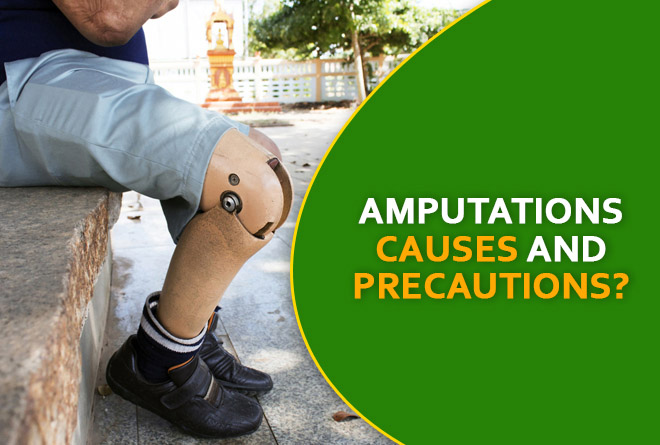
Diabetes is in itself not only about less insulin and high sugar levels in the body. It can lead to nerve damage and a reduction in blood circulation. These two conditions can make the feet vulnerable to skin sores or ulcers. These ulcers can magnify in no time.
Amputation is the removal of a limb by trauma, medical illness, or surgery. It is an extreme precaution taken when a wound does not heal for a long time. Diabetes is one of the major reasons that lead to slow healing. It often leads to gangrene and amputations.
Statistics have proved that India is the capital of Diabetes in the world. This life-threatening disorder is becoming an epidemic and affecting people of all ages. As per the national conference on diabetes, India’s 15 percent of the diabetic population suffers from ulcers at least once in their lifetime. More than 80 percent of the amputations start with foot ulcers. A non-curable ulcer can cause significant damage to tissues and bone. It may need surgical removal of toe, foot or part of the leg.

Watch this Video to Know 5 Reasons For Diabetes Foot Amputation
But the good news is, with proper diabetic medication and foot care, you can prevent foot ulcers. It is found that minimum care would bring down the lower limb amputations by 50 percent.
Symptoms of Ulcer
Foot ulcers are a common complication of inadequately managed diabetes, developing as a result of skin tissue breaking down and revealing the layers underneath. These ulcers, if not treated well, increases the infections and lead to amputations. Here are a few symptoms of an ulcer, which if not taken proper care might become worse and lead to amputation.

- Toenails grew inside might cause severe damage to the nerves and blood cells.
- Blisters might not heal and lead to decay.
- Plantar warts on the foot soles that make your foot tender and cause small blood clots.
- Open sore leads to dangerous infections.
- Foul smell due to some unhealed wounds.
- Ulcer lasting for more than 1 or 2 weeks due to slow healing.
- A deep ulcer such that you can see the bone below and shows no signs of healing.
- Swelling
- Redness
- Discolored skin
[Also Read How to care for feet when you have diabetes]
Factors leading to the risk of amputation
All people with diabetes are at risk for foot ulcers. These are caused by multiple factors. Some factors can increase the risk of foot ulcers which eventually leads to deeper infections and may cause amputations, including:

- High blood pressure above 140/80
- High blood sugar levels causing slow healing.
- Nerve deterioration leading to their decay.
- Reduction in blood circulation to the nerve endings not allowing healing.
- Previous foot ulcer history, leading to further deterioration.
- Previous amputation.
- Kidney disease.
- Smoking reduces circulations to the feet.
When is Amputation Done?
Amputation is the extreme step taken when an ulcer is not healing and becomes a life threat. It usually sets out as an ulcer. Diabetes faces slow healing which makes ulcer complications worse. Sometimes the wound is so deep, that the bones would be visible resulting in excruciating pain. These kinds of ulcers stay for longer than 2-3 weeks and show no signs of healing. The tissues around them also are dead and they start to decay. The doctors try to heal them in the beginning through proper medications. When the wound is beyond any kind of medical healing, the doctors advise amputation.
In the process of amputation, the dead tissues and damaged tissues are removed with a surgical procedure. Sometimes, in severe cases, the entire limb is removed to prevent the infection from spreading further. These have a traumatic effect on the patients mentally and psychologically. With consistent rehabilitation and post-surgery precautions, the patients are helped to come back for a routine life.
[Also Read Diabetic Ulcers on Foot and Treatment]
Ayurvedic Medication!!
Diabetes is increasing radically in current times. The stress in daily life, hereditary factors, and lifestyle changes make diabetes worse. Our ignorance towards ulcers are reasons for the increase in amputation. Diabetics need to follow a healthy lifestyle. They should develop healthy food habits and exercise regularly. Following a proper diabetes treatment plan is a must to have blood sugar levels under control. Along with the above, you need to be observant about the sores and ulcers occurring in your foot. Timely help is the best precaution to take to save yourself from the pain of ulcers or wounds.
Watch this Video to Know What Is Diabetes According To Ayurveda
The ideal way of tackling diabetes is Ayurveda. It prescribes all-natural and purely herbal supplements that ensure zero side effects. These herbs have the highest anti-diabetic properties and no side effects.
FACT: The Average Lifetime Cost of Treating Diabetes Complications runs more than ₹ 50,00,000!!!
Do’s and Don’ts for Diabetes Wound Care
Remember that even a small scrape can become serious if you don’t take proper care of it. Diabetes can cause wounds to heal more slowly. This increases the risk of people with diabetes developing infections and other severe complications. Here are some of the Do’s and Don’ts for Diabetes Wound Care
What should I do?

- Wash feet daily with a non-medicated soap gentle enough for a baby’s skin
- Dry carefully between toes with cotton.
- Cut your toenails very carefully. Cut it straight across, avoiding cutting them too short or cutting into corners
- Wear only proper fitting shoes.
- Always wear a clean and dry sock.
- Walk inside the house as well as outside wearing shoes.
- Inspect or have someone check at your feet daily to see if there are discolorations of any kind
- checking your blood sugar levels regularly
- exercising for at least 30 minutes daily
- maintaining a healthy weight and blood pressure
[Also Read Diabetic Wound Care: Dos and Don’ts]
What should I avoid?

- Do not use any medication, drug, antiseptic or plaster on your feet that are not prescribed
- Do not apply hot water bags, heating pads or other heating devices to your feet
- Do not cut any hard skin, corns or calluses that you may have on your feet
- Do not smoke cigarettes – they can rob your feet off the circulation of blood they need.
- Do not cut your toenails if you cannot see well.
- Do not walk around barefoot.
- avoiding sugar-sweetened juice and soda
Conclusion :
Diabetes is one of the leading causes of health damage around the globe. It leads to various forms of diseases and in severe cases causes amputations. Studies have shown that diabetes is one of the major causes of amputation. With some basic foot care and lifestyle modifications, amputation can be completely avoided. These precautions include maintaining blood glucose levels, taking proper food care and cultivating healthy habits. They ensure proper blood circulations around the body and fast healing of wounds. By following these precautions, amputations can be easily avoided.

